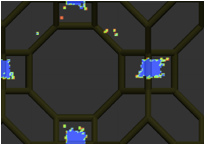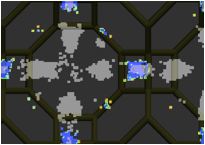58th Annual Report on Research 2013 Under Sponsorship of the ACS Petroleum Research Fund
Reports: UR551765-UR5: Atomistic Simulations of Small Molecules' Behavior Within Al Substituted Zeolites
Daniela Kohen, Carleton College
We continue to make progress in understanding and characterizing at the molecular level how small gas molecules behave within pores of molecular sieves, and how this interaction depend on the polarity of the systems involved. Micro-porous and nano-porous materials are widely used in catalytic and separation processes. Our atomistic simulations provide basic scientific insights that complement experiments and facilitate the development of new materials that can both be effective and inexpensive. Following initial work simulating the behavior of mixtures within silicon only zeolites, the projects funded by this grant have focused on the properties of gases within related zeolites where Coulombic interactions would probably greatly impact behavior. In particular, we are embarked in a systematic study of the adsorption and diffusion of differing polarity gases within zeolites modified by substituting silicon atoms by aluminum atoms.
The first steps in this project have been to make sure we have accurate methods and potentials. In the summer of 2012, we focused on studying carbon dioxide in Al-substituted silicalite (MFI). The choice of CO2 and MFI was not random. MFI is a widely used and studied zeolite. Furthermore, my group had previously studied silicalite quite extensively. Carbon dioxide has a quadrupole and not a dipole however, we have demonstrated, while being funded by a previous PRF grant, that the coulombic interaction that the quadrupole generates results in dramatic effect on its behavior within zeolites (and contrast nicely with nitrogen, a clearly non polar molecule). In addition, potentials for carbon dioxide within this zeolite were available. Grand Canonical Monte Carlo methods were used to study adsorption. In the past, we have been using a cut-off method to model long range electrostatic interactions. The introduction of stronger electric fields necessitated the use of the Ewald summation method. This method was successfully implemented during that first summer. Previous studies in MFI using large cutoffs for electrostatic potential were reproduced (at much lower computational expense). Also other authorsÕ work on this system was reproduced, validating our code. Preliminary studies of the preferential siting of cations and carbon dioxide within MFI were also conducted. These suggest that within straight channels evenly spaced aluminum substitutions increase the number of CO2 preferential adsorption sites; this number also increases at that low CO2 loading. However, our preliminary results also indicate that, for a given Si/Al ratio, the number of CO2 preferential adsorption sites does not correlate with CO2 loading at atmospheric pressure.
The second summer, we turned our attention to Al-substituted ZK4 (LTA4A). ZK4 cage structure results in very interesting behavior derived from the fact that a preferred site for the carbon dioxide is within the narrow pores connecting cages; we were curious about the effect of aluminum substitutions on this. In addition, LTA4A is another well-studied material. However, it has a more chemically complex structure than MFI, with many more Al (and corresponding mobile cations) so its study presents many more simulation challenges. Most of the summer was spent working on finding equilibrium positions for the mobile cations. Also, as the long-range interactions determine so much of the behavior optimizing the Ewald method was crucial. Despite these challenges, the preferred sites of the mobile cations in empty zeolites were explored and compared to experimental results both qualitatively and quantitatively. We also started to look at how these preferred sites changed when CO2 molecules adsorbed onto the zeolite. One of Na+'s preferred sites is within the narrow neck connecting a-cages. Preliminary results show that this is still true when there are carbon dioxide molecules within the zeolite (see below). Thus, Na+ adsorption sites within LTA4A compete with CO2 preferred sites, which we believe is a result of carbon dioxide polarity.
 |  |
|
Na+ free energy landscape |
Na+ free energy landscape in the presence of adsorbed CO2 (grey) |
Two students were supported in the summer of 2012 and two in 2013 by this grant. Our work has resulted in four studentsÕ talks at the regional MU3C meeting, two studentsÕ talks to the members of the Carleton chemistry department doing research over the summer and two posters presented at an all-science poster session at Carleton College. It has also resulted in posters presented by the PI at a ZeoliteÕs Gordon Conference, at the Porous Materials Workshop (CPM-6) and at the Foundations of Molecular Modeling and Simulations Conference. Finally, it also has resulted in a poster in the National ACS meeting presented by a student.
Copyright © 2014 American Chemical Society











